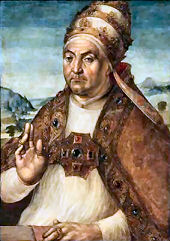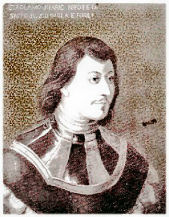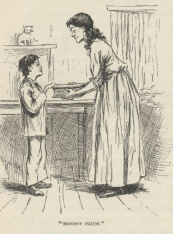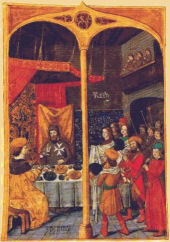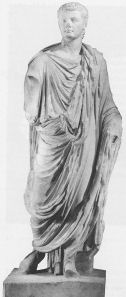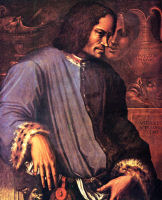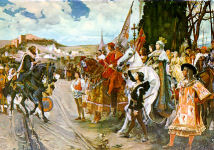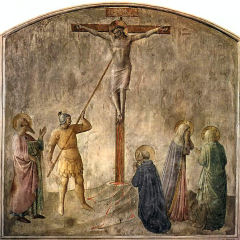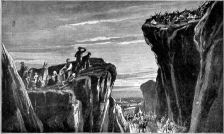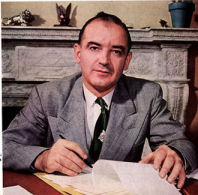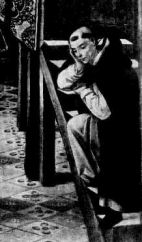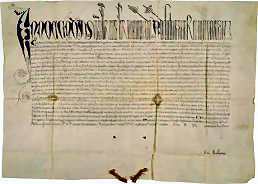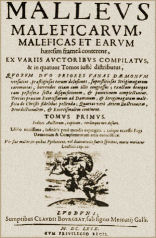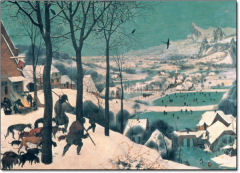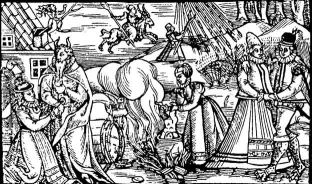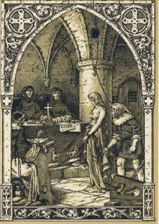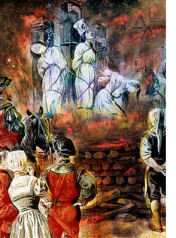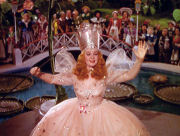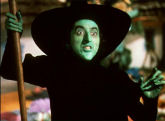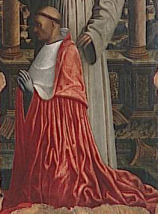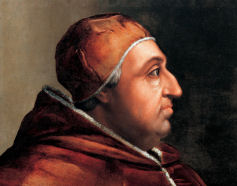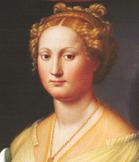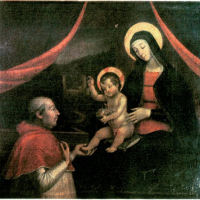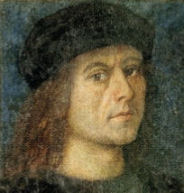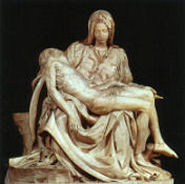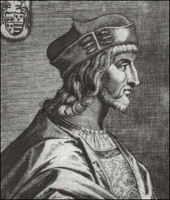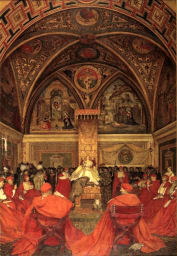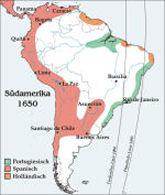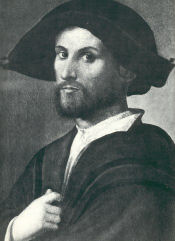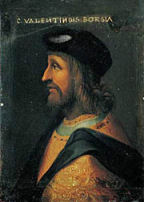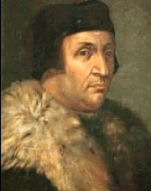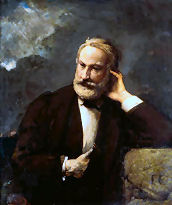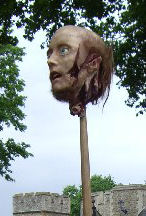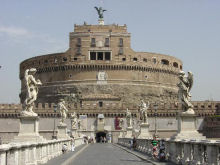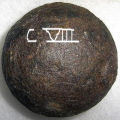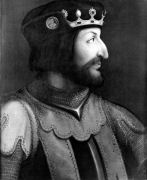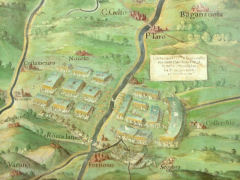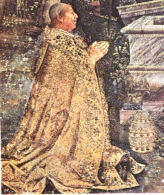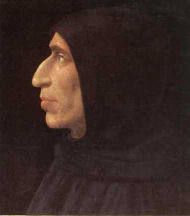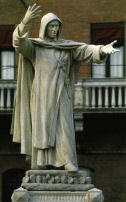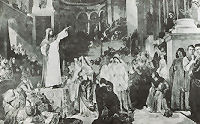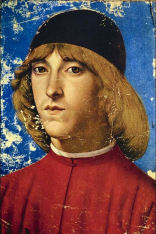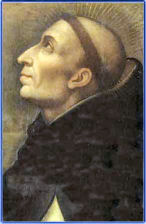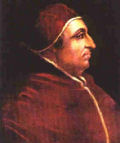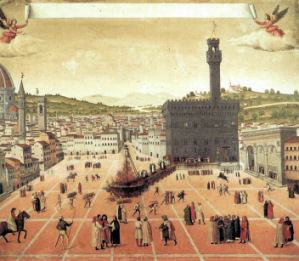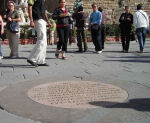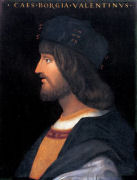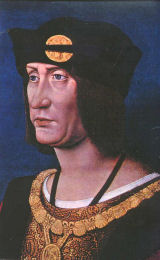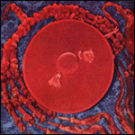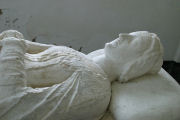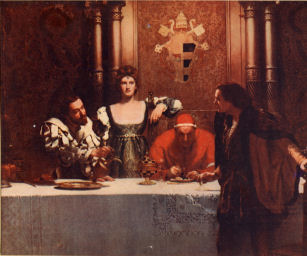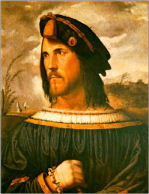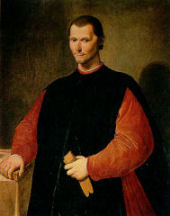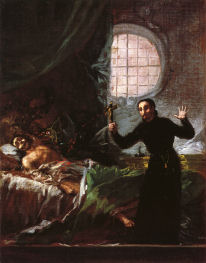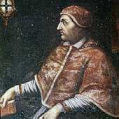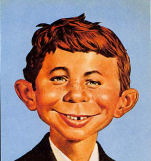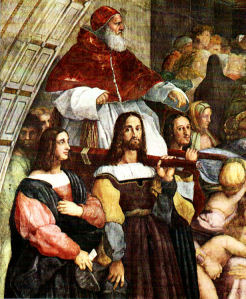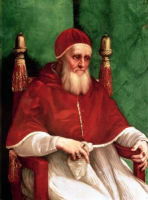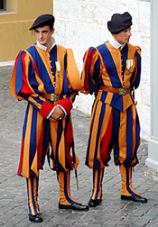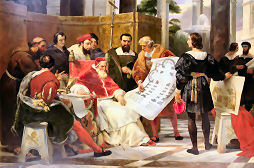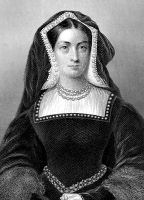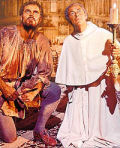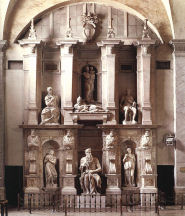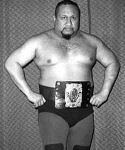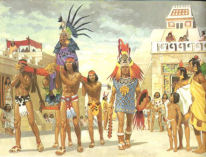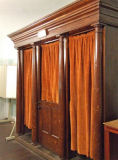Chapter 16: The March of the Nephews
Pater Romae
Peace may have killed Pope Sixtus IV. “At last he received intelligence that his allies had concluded a peace without consulting him, and became so exasperated as to induce a violent fit of the gout, to which he was subject, and he died, after a few days illness, on the 13th of August, 1484.”[1] Three of the thirty-two cardinals at the conclave antedated Paul II’s papacy – the two Borgia nephews and the Piccolomini nephew. Six had been appointed by Paul II, among whom were his three nephews, Uigi, Duigi, and Luigi. The other twenty-three cardinals were all Sixtus IV’s creatures. No less than eleven relatives of past popes and four cardinals destined for the papacy attended the conclave. Ecclesiastical lawyers employ the adjective “canonical” to denote a legitimate election of a new pop. The following passed for canonical in 1484. A civil war between the Colonna and the Orsini families had erupted in and around Rome. Pope Sixtus’s death precipitated mass rebellion. The well-to-do clergy and nobles barricaded themselves into their palazzi to wait out the storm. The mob pillaged house after house. The papal nephew Girolamo Riario could not defend his Roman palazzo; it was stripped clean. The Colonnas and Orsinis brokered a temporary truce; both families abandoned the city. Girolamo Riario and his wife hosted the conclave in the Castel Sant’Angelo. Every cardinal committed to certain stipulations if elected pope. To avoid the enforcement problems that had hobbled the previous prenuptial agreements, the cardinals underwent a solemn ritual. They crossed their hearts, affirmed “Honest Injun,” and swore a sacred oath that:1. The new pope would pay one hundred ducats per month to every cardinal whose yearly income totaled less than four thousand ducats.
2. A crusade would be launched against the Turks.
3. The Roman curia would be completely reformed.
4. No one under thirty would be named a cardinal.
5. No more than one relative of the pope could become a cardinal.
6. The total number of cardinals would be permanently fixed at twenty-four.
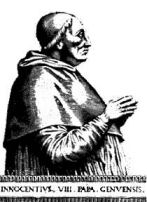
The approach lacked subtlety, but it worked; Cardinal Civò became Pope Innocent VIII. In all of papal history his eight-year pontificate may contain the most astounding concentration of curiosities.
• Pope Innocent worked out the deal[3] for detention of the Turkish Sultan’s brother Djem. As Phillip Schaff has noted, “This incident in the annals of the papacy would seem incredible, if it were not true. A writer of romance could hardly have invented an episode more grotesque.”• Innocent openly recognized at least two illegitimate children,[4] Franceschetto and Theorina, who were probably born before Civò was ordained. Rumor attributed to the pope an additional fourteen or more offspring. In all cases the mothers were married. A popular couplet described him with these words:
Octo nocens pueros genuit totidemque puellas,
Hunc merito poterit dicere Roma patrem.
The wicked[5] man fathered eight boys and as many girls;
Thus Rome will justly be able to call him father.
• Pope Innocent was Rome’s worst ruler since Caligula. The crime rate during his pontificate was astounding. Rape and murder were commonplace throughout the city. “No morning dawned without revealing corpses in the street.”[6] If that account even approximates the truth, then Rome, a town too small for a mall by today’s standards, witnessed as many murders as twenty-first century New York.[7] Churches were routinely looted; even the True Cross was stolen for its mountings.
One obvious source of the crime problem was the pope’s approach to law enforcement. Trial and imprisonment were rare. Instead, fines that enriched the pope’s son, Franceschetto, and the vice-chancellor, Cardinal Rodrigo Borgia, were levied. Borgia has been widely quoted as explaining that “God desires not the death of the sinner, but rather that he should pay and live.” The fines soon became a calculable cost of criminal enterprise. This attitude might have been Borgia’s idea. Even so, the pope could easily have put the kibosh on these shenanigans, but he never did.
The pope’s laissez faire attitude specifically excluded the forgery of papal documents, which threatened the lucrative papal monopoly on dispensations. At least two people were executed for this crime.• Pope Innocent initiated the Church’s long futile effort to control printing. By this time a significant number of written works had been published, especially in Germany. The pope issued a universally binding bull prescribing censorship of all books. The bishops were ordered to enforce it, but most paid little heed to his unfunded mandate.
• The new pope appointed fewer relatives[8] than his predecessor, but he ignored his other promises. He even named a thirteen-year-old cardinal, Giovanni de’ Medici. The Holy Father put the kid on probation until he was old enough to shave. Giovanni’s father was the pope’s banker, Lorenzo de’ Medici, who had narrowly escaped assassination in 1478. His generous funding of Renaissance art earned him the epithet “the Magnificent.” Lorenzo also gave the hand of his daughter Maddalena to the pope’s wastrel son, Franceschetto. • During Innocent’s pontificate King Ferdinand drove the Saracens out of Spain. The decisive victory came at Granada in 1492. As spoils of this great triumph Ferdinand enslaved one hundred captured moors and presented them to the Holy Father. The spirit of largess overwhelmed the pope, and he regifted the enslaved souls to his Roman friends.• The pontiff kept for the Church a priceless object recovered from the Muslims – a piece of metal identified as the Lance of Longinus. Everyone from the pope down to the most disease-riddled prostitute became convinced that it was the same scrap of iron that Peter Bartholomew had produced in St. Peter’s Church in Antioch during the First Crusade, the spearhead allegedly used over fourteen centuries earlier to pierce Jesus’s side. And yet:
1. The item had been missing for hundreds of years.
2. Its source was the hated Turks, who had already conquered the Christian city of Constantinople and obviously coveted the rest of Europe.
3. Peter Bartholomew’s trial by fire had denied the authenticity of the piece.
4. At least two other European cities, Nuremburg and Paris, claimed to possess the original lance.
Just as in 1098, Christians interpreted the recovery of the head of the lance as a sign of God’s favorable judgment. Three separate contemporary chronicles described the celebration in Rome; wine flowed from the city’s fountains!• Pope Innocent lacked interest in a crusade to the Holy Land, but in 1487 he declared a mini-crusade in the Dauphiné region of France against the Waldensian fundamentalist sect. Its leaders preached that the popes and bishops were guilty of homicide in the crusades.
Something Wicked This Way Comes
Pope Innocent’s attitude concerning witches resembled Joseph McCarthy’s toward Communists. Both found their hated adversaries in every closet, and both acted decisively to extirpate them. However, the junior senator from Wisconsin never had the Inquisition at his disposal. During Innocent’s pontificate the notorious Dominican monk, Tomás de Torquemada,[9] served as Grand Inquisitor.Popes had occasionally addressed the subject of witchcraft. Pope Gregory IX in 1233 detailed the obscene ways in which devils and demons procreated with women to create witches. St. Thomas Aquinas, whom two popes had declared an authoritative guide on all matters theological, expounded upon the sexual congress of humans and demons and the magical powers of women. Pope Eugene IV often spoke of pacts between humans and demons. None, however, went as far as Pope Innocent, whose famous bull, “Summis Desiderantes Affectibus,” attributed to witches the power to render men and women sterile, to slay infants in the womb, to destroy crops, and to kill animals. It specifically targeted the areas of Mainz, Cologne, Treves, Salzburg, and Bremen, which were reportedly (Pope Innocent never personally visited these cauldrons of iniquity) teeming with witches. Thenceforward denial of witchcraft officially constituted heresy, punishable throughout Europe by death on the pyre. Pope Innocent’s actions brought witchcraft under the Inquisition’s purview and subjected all accused witches to torture and, when they confessed, public burning.
In 1486 the pontiff assigned two Dominican inquisitors the task of writing a handbook entitled Malleus Maleficarum, Latin for “The Hammer of the Female Evil-doers.” This book provided the basis for torturing[10] untold numbers of women into confessing to witchcraft. Most were subsequently executed. The families of the convicted were forced to effect monetary retribution for the witch’s sins. Strong financial incentives therefore impelled Christians to inform the inquisitors whenever females started acting weird.The crackdown was counterproductive; the practice of witchcraft increased dramatically. Black masses and other occult rituals described in Malleus Maleficarum became much more commonplace. Women actually accused themselves of witchcraft. In a few cases whole convents of nuns met their end in flames. Wow! Thank goodness Sr. Mary Immaculata never taught us about that development. Any thought of flaming nuns would have doubtless generated unwholesome notions in the minds of restive ruffians in her class.
At the end of the fifteenth century the Little Ice Age began to grip Europe. In the next two centuries an unusual incidence of failed crops, dead animals, and stillborn infants would beg for explanations. Accusing fingers ended up pointed at women, especially elderly spinsters. There is no proof that witches ever successfully cursed or caused harm to anyone associated with the Inquisition. One can equally well interpret this failure as a demonstration of the protective power of doing the Lord’s work or as an indication that witches were overrated. Why did Innocent VIII blame the rash of problems on hapless women? No explanation is completely satisfying. He issued no other noteworthy theological judgments. He was not especially misogynistic; he absolutely doted on his daughter Theorina. He received little if any financial gain from the prosecution of witches. As painful as it is to admit the lack of identifiable papal trickery, the pope and others involved in this mad campaign were evidently quite sincere. Nearly everyone believed in witchcraft,[11] which is often mentioned in scripture. In the fifteenth century all Europe seemed convinced that witches were on the rampage. Writers had propounded a taxonomy of the phenomenon and described the paranormal abilities that the devil bestowed. Psychopathologlogy and the scientific method were unknown. The torture and execution of witches seemed to Christians a measured reaction to a serious problem. Witches and other minions of the devil had no human rights. People probably expected Pope Innocent to react to reports of witchcraft in Germany as previous popes had tried to respond to the plague. Plagues were acts of God; witches did the devil’s work. Unlike the plague, witches were a problem well within the Church’s traditional dominion. Why would any fifteenth century pontiff fret over a few hundred females aflame on the pyre? Their resemblance to human women was a diabolical illusion. Due process in established tribunals demonstrated the creatures’ demonic nature. Exodus 22:18 clearly ordered: “Thou shalt not suffer a witch to live.” Pope Innocent simply clarified a basic force of nature. Pope Innocent’s bull had an unchallenged biblical basis, and other popes had issued such clarifications. In contrast, the constitution issued in 1854 by Pope Pius IX affirming the Immaculate Conception[12] directly contradicted previous papal opinions. Additional striking differences between the two types of encyclicals are noteworthy. Whereas Pope Pius IX’s encyclical “Ineffabilis Deus” added a new wrinkle to existing beliefs, “Summis Desiderantes Affectibus” effectively outlined a new religion, even if its core beliefs were already tacitly affirmed by nearly all Christians. Innocent attributed supernatural powers to devils, demons, and witches. Previously Christian doctrine had ascribed supernatural powers only to God. The Nicene creed, the basis of the Christian faith for one thousand years, never mentioned the devil or witches. Pope Innocent effectively annexed superstitions from northern European mythologies into the Roman canon!The practical difference is even more striking. Even in Pope Innocent’s time doubting a matter of faith was not generally dangerous as long as one kept silent. Discretion, however, was no safeguard against an accusation of witchcraft. A single woman past her prime faced jeopardy any time that a tragedy befell her community. Once accused of witchcraft, a woman’s chances before an Inquisitor were not good. Fortunately, the attitude of the Church has evolved. Bringing up the subject of witches is now considered bad form. Most theologians today consider “Summis Desiderantes Affectibus” an embarrassment. For example, few modern clergymen would site it or Malleus Maleficarum to convince the prefect of the Congregation for the Doctrine of the Faith, the successor institution to the Inquisition, that Hillary Clinton was a witch.
Students in Sr. Mary Immaculata’s class understood a different taxonomy of witches. The ones with green faces and bad nose jobs used flying monkeys to harass scarecrows, little dogs, and the like. The pretty ones with wands and funny voices were a whole different species. We never heard of burning evil witches; our understanding was that throwing water on them made them melt.We had also heard stories of regular people being burned to death. S’ter explained how the Romans tried to execute St. Lawrence on the spit. “Turn me over,” he said. “I’m done on this side.” I have no recollection of any such description of burnings in which Christians lit the fires.
Family Values in the Papacy
Pope Innocent’s last year was the most bizarre. Filippo Valori, a Florentine ambassador, reported that the pope slept almost all day and grew grotesquely obese. In his final days he reportedly subsisted solely on milk from a woman’s breast. Stefano Infessura wrote that in a desperate attempt to save the pontiff’s life Pope Innocent’s Jewish doctor arranged the world’s first blood transfusion. All three young donors and the Holy Father himself reportedly perished in the attempt. If a real transfusion had actually been attempted, then the outcome was essentially foreordained. Blood typing, which is absolutely critical to a transfusion, was not standardized until 1901. Most historians discount Infessura’s report; the blood was probably administered orally, if at all. Since the Council of Constance, seven of eight popes had been Italian, and their conduct had not exactly been exemplary. So, why did Sr. Mary Immaculata claim that the Holy Spirit insisted on Italian popes? Well, S’ter knew her history. The Spaniard elected pontiff in 1492 proved her point. The frontrunners in the conclave were two papal nephews, Rodrigo Borgia and Julian della Rovere. The two papabili joined twenty-one other cardinals in the conclave. Philip Schaff wrote that seventeen of them left richer, some much richer, a few weeks later. The French king, Charles VIII, had deposited on Della Rovere’s behalf a staggering sum in banks in Rome and Genoa. Borgia, on the other hand, mostly employed the same grass-roots chicanery and bribery that had worked for Civò. He ascertained from each cardinal the price of his ballot. With the magnetic force of his personality, promises of plum appointments and benefices, and cash from his personal fortune[13] amassed over decades of managing the Church’s finances, he won just enough votes.[14] The Church had lacked a pope for only seventeen days[15] when Rodrigo Borgia ascended St. Peter’s throne as Alexander VI. Practically no one defends his pontificate. Its hallmarks were sex, nepotism (or rather “filiism” since the prolific pontiff seldom needed to look beyond his own children), simony, war, and sudden death. There is no sense in mincing words about one aspect of Pope Alexander’s character; the guy was a philanderer. He openly slept around all his life. He treated his mistresses respectfully, and he was a good provider for his many children. He publicly claimed at least nine bastards; he even allowed them to use his surname. He was sexually active even after becoming pope at age sixty-one. Throughout his pontificate he publicly kept a young mistress named Julia Farnese. She had a husband, but when the pope craved female companionship, Alexander kept him occupied elsewhere.In fairness one should also note a few positives about Rodrigo Borgia. This remarkably accomplished man managed the Church’s finances for thirty-seven years over the course of five pontificates during which the papacy emerged from near extinction to a state of fabulous wealth. To a great extent Cardinal Borgia is rightly credited for this stunning turnaround. His methods may not have been strictly kosher, but they worked.
Pope Alexander was a much more effective ruler of the Papal States than his immediate predecessors. He quickly put a showy end to the mollycoddling of violent criminals. The crime rate dropped to near normal. His superb artistic taste enriched future generations. He hired Pinturicchio to decorate his apartments in the Vatican and threw a few bones to Perugino, Volterrano, and Peruzzi. Michelangelo Buonarotti’s Pietà was completed and placed in a side chapel of St. Peter’s for the Jubilee year of 1500.Pope Alexander somehow saved the papacy in an extremely dark hour. Before due homage is paid to his greatest trick, however, a few unusual aspects of his pontificate deserve attention. His Holiness had a well-earned reputation as a party animal. When still a cardinal he was chastised in writing by Pope Pius II for participating in a bacchanalia in Siena. This letter is widely quoted. “We have heard that the most licentious dances were indulged in, none of the allurements of love were lacking, and you conducted yourself in a wholly worldly manner. Shame forbids mention of all that took place. … All of Siena is talking about this orgy.” Alexander VI’s coronation party was another world-class bash. By all accounts it put to shame all previous celebrations. The city was festooned with images of the bull passant, the symbol of the Borgias. A fountain in the shape of a bull was constructed. Wine flowed from some orifices, water from others. His Holiness also enlivened the Roman social calendar with many lavish entertainments, including bullfights in the Piazza San Pietro and some memorable orgies.
Pope Alexander declared 1500 the eighth Jubilee Year. Great sums were collected that year in support of a Turkish crusade that never quite materialized. In a Spanish bullfight staged in St. Peter’s square Cardinal Caesar Borgia killed five bulls. Perhaps they were distracted by the sight of the matador’s red hat.The pope’s sober master of ceremonies, Johann Burchard, wrote of another famous party. The pope and his daughter Lucretia (also written Lucrezia) were on the judging panel as fifty prostitutes and as many palace servants vied in a sort of sexual “So You Think You Can Dance” for prizes offered by the Holy See. After the competition, chestnuts were dispersed around candelabra. The naked harlots and their ad hoc partners scurried around on hands and knees to gather them.
Two other papal fetes were equally notorious. One featured stallions and mares herded into a Vatican courtyard, where they were encouraged to mate for the Borgias’ amusement. In another Caesar reportedly shot down criminals who were driven like animals within bowshot. It has also been alleged that Caesar could behead a bull with one fell stroke, but unless he had access to Luke Skywalker’s light saber, that yarn has one too many bulls for my taste. A bullfrog certainly, a bulldog maybe, but male bovines have awfully thick necks. Who can say? Caesar certainly knew a trick or two.
Pope Alexander skillfully augmented the cardinal-packing trick with a simony flourish. The thirteen cardinals named in the first year included Alexander Farnese, the brother of the pope’s young mistress. Most others paid for the privilege. In 1496 four Spanish cardinals were named, including the pope’s nephew, Giovanni Borgia.[16] The next year the red hat was placed on the comely head of the pope’s twenty-two year-old son, Caesar. In 1500 positions for a dozen more cardinals were created; the revenues funded Caesar’s adventures. In 1503 another nine men were awarded the purple.[17] These appointments simultaneously assured the papacy’s solvency and the durability of Alexander’s influence. On May 4, 1493, only six months after Columbus’s return from the West Indies, Pope Alexander’s famous bull (not the kind that Caesar beheaded) “Inter Caetera,” ceded all land more than one hundred miles west of Cape Verde and the Azores to Spain.[18] What other pontiff would have dared to make such a brazen move? The pope’s claims to his own territories had been shaken by the exposure of the Donation of Constantine as a forgery. Nevertheless, he acted as if it were common knowledge that the entire western hemisphere, inhabited by rather sophisticated people,[19] was his to dispose of. His decree secured crucial support from Spain in the chaotic Italian war that threatened his pontificate. The case has been made that this bull invented the concept of the missionary.[20]
Pope Alexander was remarkably tolerant of Jews and Muslims. He did not inherit his predecessor’s obsession with witchcraft; he was accused by some of being a sorcerer himself. A future pope asserted that he was a closet Jew or Muslim. All these claims were completely baseless. Seldom has anyone been slandered more than Alexander VI and his children. Many people insisted that the pope had concocted a poison called “white powder” that mysteriously remained latent in a victim’s digestive system for a few days or weeks and then turned toxic when the Borgias had established alibis. The pope’s arrogance and his son Caesar’s ruthlessness made many enemies. Every strange or violent crime that befell anyone close to the pope’s family was pinned on the Borgias by one chronicler or another. Here is a partial list.
• Many have asserted that Rodrigo Borgia killed a playmate when he was twelve.
• In 1494 King Charles VIII of France took Djem hostage. The Turkish prince perished suddenly after a meal. Although no Borgias were in the vicinity, the pope and/or Caesar have been widely blamed.• In June of 1497 the pope’s son Giovanni, the Duke of Gandia, was tied up and stabbed a dozen or so times; his throat was slit; then he was thrown in the Tiber. The pontiff ordered a search for his son’s body and was devastated when it was recovered. The crime was never solved. Despite the lack of evidence, some saw this as Caesar’s work. Although Caesar eventually did assume the role of Captain-General of the Church, he inherited neither his brother’s land nor his title.
• In September 1497 three servants of the Archbishop of Cosenza were caught with forged documents. The pope cast the archbishop into a cell in Castel Sant’Angelo, where he was put on a diet of bread and water until he expired. The three minions were treated to a more rapid and much warmer death in the Campo di Fiori.
• In 1500 Lucretia Borgia’s beloved second husband, Alfonso of Aragon, the Duke of Bisceglie, was assaulted on the steps of St. Peter’s. He lived for thirty-three days and then was, according to Burchard, “strangled.” Later writers associated Caesar with this murder as well, but at the time the only person who condemned him was the Venetian ambassador, Paolo Capello, whose account contained several inconsistencies.• During his protracted siege of the town of Faenza, Caesar hung a local citizen named Grammante who had brought Caesar information about weaknesses in the town’s defenses. Previously Caesar had sent to the gallows two men who had violated his order against pillaging Forli. Expecting clemency from Caesar Borgia was a mistake, often a fatal one.
• Astorre and Gianevangelista Manfredi, the hereditary rulers of Faenza, were incarcerated permanently in Castel Sant’Angelo. Caesar had previously agreed to release the valorous teenager Astorre; he never explained his change of heart.
• Four members of the house of Marescotti who had been imprisoned by the Lord of Bologna, Giovanni Bentivogli, were killed by Hermes Bentivogli and other young Bolognesi. Guicciardini blamed Caesar for even these murders.• Thirty women were captured and brought back to Rome after Caesar’s siege of Capua. Guicciardini upped the number to forty and claimed that Caesar claimed them for his harem.
• Caesar’s men seized a Neapolitan named Mancioni. They cut his tongue out and severed his hand. The two appendages were displayed in a church window as a warning. At about the same time a Venetian pamphleteer who had libeled the Borgias was seized and executed.• In Victor Hugo’s play Lucretia Borgia poisons everyone and his pet hamster. In real life she was known as a rather passive figure.
• Ramiro de Loqua, one of Caesar’s Governor-Generals, earned his boss’s disfavor for overly severe tactics in governing. He was found beheaded in the street on the day after Christmas. The missing piece was mounted nearby on a pike.• The leaders of a revolt against Caesar’s forces were duped into a meeting in Sinigaglia when they thought that Caesar was at his weakest. He arrested and tried them. All save the Orsinis were strangled.
• Cardinal Orsini passed away while imprisoned in Castel Sant’Angelo. Many people accused the Borgias of poisoning him, but his body showed no visible signs of venenation.• Cardinal Giovanni Michieli died within six weeks of contacting a violent illness. Years later a subdeacon named Asquino de Colloredo confessed under torture that the pope and Caesar had forced him to poison the cardinal. The ambassador to Venice reported that Pope Alexander had confiscated the cardinal’s possessions on the night of his demise.
• Some attributed Cardinal Gianbattista Ferrari’s death to the Borgia’s white powder.
• After a supper party at Cardinal Corneto’s villa both the pope and Caesar became violently ill. Caesar recovered, but the pontiff died. Pietro Martire d’Anghiera wrote from Spain that their attempt to poison the host had misfired. The Borgias allegedly acted in a clumsy or incompetent manner. If so, it was the only time either man displayed either quality. D’Anghiera also claimed that Caesar, who was completely incapacitated for months and actually lost a layer of skin as a result of the illness, recovered by being dunked in a jar of ice water. The explanation evolved into the claim that he had been wrapped in the entrails of a recently killed mule. In a later version the mule transmuted into a bull.
Dodging the French Bullet
Penn and Teller often have often closed their stage act with “The Bullet Catch.” One magician fires through a pane of glass a bullet marked by a third party. The other appears to catch the bullet in his teeth as the glass shatters. As stunning as this trick is, it is child’s play compared with what Pope Alexander’s conjuried for King Charles VIII of France.In any fair contest no one would bet on Charles over the pope. Charles was a short ugly man whose meager intellect was demonstrated by the fact that he died in a coma after striking his head while walking through a doorway. Thirty-nine years younger than the pope, he knew little of the world’s ways. Alexander was large, handsome, charming, and athletic. People magazine named him the sexiest man alive every year from his appointment in 1455 as vice-chancellor until his son Caesar began beheading bulls and stealing hearts in 1492. Pope Alexander was also as crafty as anyone who ever donned the tiara.
In this confrontation, however, the king had a staggering advantage – an army of forty to sixty thousand disciplined soldiers accompanied by the first train of artillery ever seen in Italy. The king was so proud of his big guns that he etched his initials into every cannonball.[21] At the time the Italian peninsula was divided among the Aragon-controlled Kingdom of Naples, the Papal States, and a number of city states – Milan, Genoa, Florence, Venice, etc. – with modest forces and soundly based mutual suspicions. Ludovico Sforza, Milan’s dictator, had invited Charles to conquer the Kingdom of Naples. Charles’s claim dated back to the Anjous. He also apparently entertained delusional dreams of occupying the throne in Jerusalem.Charles and his army retraced Hannibal’s route across the Alps. The campaign through the Papal States separating the north from Naples started quite well. In only two months the king, his troops, and his cannons were in the Eternal City. The outlook for Alexander’s papacy was dismal:
• The Colonnas had captured Ostia in the name of France.• The Orsinis offered to admit the French to their castles.
• The Turkish sultan’s offer of financial support to the pope in exchange for Djem’s murder[22] had been intercepted and was in Charles’s hands.
• Cardinal Della Rovere and other influential clerics encouraged the king to depose the pope and convene a council to name a replacement.
• The pope’s army, mostly mercenaries of questionable dependability, was no match for Charles’s.
Nevertheless, Alexander never yielded. He took refuge in Castel Sant’Angelo, and for two weeks he faced the king’s cannons from a window of the dilapidated fort. Then he somehow negotiated an amazing truce. The king acknowledged the legitimacy of Alexander’s pontificate. He even planted a French kiss on the papal slipper. The pope consented to the following:• He abandoned his alliance with the Neapolitan regime. He had cemented it a few months earlier by marrying one of his sons into the royal family of Aragon.
• He named two French bishops as cardinals.
• He ceded a few papal properties to the king for the housing of his troops.
• He turned Djem over to the French.
• He granted free passage to the French army through the Papal States.
• He ordered his son Caesar to accompany King Charles on his journey to Naples as a hostage.
What a great deal for the pope! His only bargaining chips had been his personality and his title. Nevertheless, King Charles ignored Cardinal Della Rovere and let the pope off of the hook. He did not depose him, insist on a council, or demand papal reforms. He never even required that the pope open Castel Sant’Angelo to the French. In actuality, the pope’s concessions amounted to little or nothing. Djem died within a few weeks. Caesar escaped using a Spanish variant on the Indian Rope Trick. King Charles seized Naples without difficulty, but he couldn’t hold it. Conquering Italian cities has always been much easier than ruling them. The pope, the emperor, the Spanish king, and most of the Italian city-states united against Charles. After the bloody battle of Fornovo in July, 1495, the French king escaped with his army, but he abandoned his Italian booty. Within a few years Caesar Borgia recovered the pope’s lost territories and a great deal more. The French invasion stained Italy. The soldiers faced no resistance whatever in entering Rome, so they could hardly claim the need to let off steam. Nevertheless, while Pope Alexander was under siege, the French army upheld the Christian tradition of sacking the city. In addition, when they finally departed the peninsula, they left behind syphilis, known in Italy as “the French disease.”[23]After the French had been repulsed, Pope Alexander could be found sitting tranquilly in his Vatican apartment contemplating the prayerful pose chosen by Pinturicchio for the papal portrait.[24] The pontiff bestowed on the assembled staff his most fulsome grin and then reached between his clenched teeth. He leaned over, ducked his head to one side, and produced – a cannonball! He arched his eyebrows and showed everyone assembled the quite legible markings of King Charles VIII of France.
Fired Up in Florence
The one Italian city missing from the alliance against King Charles was Florence. The one Italian dynasty that scarcely merited a footnote in the defeat of the French was the Medici family. The key Florentine player was a Dominican monk, Girolamo Savonarola. In his era few Europeans read the Bible in any language. Savonarola literally knew it backwards and forwards; he studied it thoroughly in both Hebrew and Greek. In 1481 the monk was assigned to the convent of St. Mark’s in Florence, a city that was slow to appreciate his sermons. His preaching in Brescia on the Book of Revelation in 1486 brought his first notoriety. In 1489 Lorenzo de’ Medici asked him to return to Florence. The people thronged to hear his homilies, which reportedly contained the distilled essence of lightning and thunder. From ten to twelve thousand people packed the cathedral to revel in his paeans to divine benevolence and his dire warnings foretelling God’s impending wrath. People were moved to tears, and not solely by rhetorical tricks. Savonarola was, in Schaff’s words, “burning with religious passion.” Lorenzo’s relationship with Savonarola was frosty. On his deathbed in 1492 Lorenzo craved the famous preacher’s absolution. The monk reportedly attended Lorenzo at his bedside, but he imposed three conditions for absolution:[25] 1) Lorenzo must demonstrate a faith in the mercy of God; 2) he or his sons must return all illegally obtained property; 3) he must grant freedom to Florence. Lorenzo allegedly agreed to the first two without hesitation, but he drew the line at liberating Florence. Savonarola never granted absolution. Over time Savonarola’s sermons became more and more strident. War dominated his imagery. Piero de’ Medici, Lorenzo’s son and heir, insisted that Savonarola leave Florence. After he preached for a while at Bologna and Prato, however, his return to St. Mark’s received an enthusiastic welcome. Pope Alexander removed the convent from control by Dominican hierarchy in Lombardy, and Savonarola transformed it into a dynamic center for the advancement not only of faith, but also art and oriental languages. What a recruiter! Even the well-heeled youth lined up to take their vows. The number of monks rose from fifty to 238. Piero de’ Medici inherited neither his father’s personality nor strength of character. When Charles VIII threatened Florence, Piero paid him a large tribute and ceded the towns of Pisa, Leghorn, and Sarzana. After Savonarola personally negotiated with the French king in Florence, he concluded that Charles had been sent by God to eradicate clerical corruption in Italy. Savonarola seemed to persuade the king to his viewpoint, too. Charles both restrained his troops from sacking Florence and reduced the Florentine tribute.Not long after Charles left town, the Medicis were overthrown in a bloodless coup. Florence then established a religious democracy with no official leader. Its constitution, approved by the pope himself, was based on the fear of God, the promotion of the public welfare, and amnesty for political prisoners. It established a council called the Signoria that was similar to Venice’s, but without a doge. Although Savonarola held no official position in the government, he inspired all the laws. Little was done without his approval. That a democracy piloted by an unelected fanatical mystic could be quite effective defies all expectations. Nevertheless, Savonarola succeeded primarily because his first priority was the people’s welfare. He implemented many policies aimed at income redistribution, full employment, and removal of corruption. He was a popular ruler.
Subsequent events strain a modern reader’s credulity. The ordinary people of Florence adopted a lifestyle almost as ascetic as their leader’s. Florentines – Florentines! – shunned fashion in favor of plain clothes. Young people of every station sought to enter the monastery. Marriage and sex came to be considered unfashionable bordering on wicked. Savonarola designated fast days throughout the year, and everyone reportedly abstained from meat whenever he advised it.Florence had been plagued by juvenile delinquency. In carnival season boys had engaged in “the festival of the stones,” in which they extorted money from their elders, performed wild nocturnal dances around bonfires, and threw rocks at citizens and their houses. In 1497’s carnival, by contrast, followers of Savonarola encouraged people to donate their costliest possessions to the poor. Young people collected various “vanities” – masks, dice games, and other objects related to carnivals of yore – from the citizenry. They piled the knickknacks in the Piazza della Signoria and set them ablaze.[26]
Having cleaned his own house, Savonarola directed his attention to the rest of Italy. He railed against the widespread corruption, unrepentant simony, nepotism, flagrant immorality, murder, rape, and unbridled mayhem throughout the peninsula. He named names, and Pope Alexander VI’s topped his list. The wily pope attempted to win over Savonarola by offering to make him a cardinal. The only documented downside to the red hat was that after a night of carousing it tended to bring out unsightly blood vessels in a cardinal’s eyes. The income was fabulous, and the work was negligible. A cardinal’s sole discernible responsibility was attending conclaves. Savonarola, however, refused to become beholden to the Holy See. He replied, “No hat will I have but that of a martyr reddened with my own blood.”
In July of 1495 Pope Alexander, having disposed of King Charles VIII’s invasion, invited Savonarola to Rome. The monk declined. He also refused a second invitation that was a little more like a summons. The third request included the threat of an interdict on Florence. Savonarola never responded to that one, but he tactfully embarked on a tour of other Tuscan towns. He subsequently returned to Florence and resumed his vituperative denunciations up to the time of the bonfire.While the Medicis plotted to regain power by stirring up anti-Savonarola feelings in Florence, the pope subjugated St. Mark’s to a Dominican outpost in Tuscany. Savonarola would not yield. He sometimes temporarily submitted to the pope’s demands to stop preaching, but he always returned to the pulpit. Alexander promised to treat Savonarola well if the Florentines handed him over. Nevertheless, everything indicated that the tricky pontiff was determined to use one artifice or another to make the monk disappear.
The word spread through Florence that the controversy over Savonarola would be settled by a trial by fire. Nothing excites the popular imagination like the prospect of a white-hot flame in close proximity to human flesh. On April 7, 1498, two stacks of wood in the Piazza della Signoria were soaked with pitch and oil. The course was sixty feet long. A Franciscan monk, Francesco da Puglia, had loudly volunteered to prove Savonarola a false prophet through ordeal by fire. However, in the end Da Puglia withdrew in favor of Julian Rondinelli. Savonarola declined to participate personally, but he allowed his friend and supporter, Fra Domenico da Pescia, to submit to the trial. The event was officially sanctioned by the Signoria. Ordeals by fire were extremely rare. Florentines camped overnight in the square to secure a good view of the once-in-a-lifetime spectacle.
Savonarola led a procession of his monks into the square. The Franciscans then either smelled a rat or deliberately employed delaying tactics. First they demanded that Fra Domenico change into a new habit. Evidently they suspected that his first cowl was fireproof. They also refused to allow Fra Domenico to approach Savonarola. Who knows what they hoped to prevent? Savonarola, not Domenico, was supposedly on trial. Fra Domenico’s attempt to carry a crucifix during the ordeal caused another ruckus. He agreed to exchange the cross for a consecrated host, but the Franciscans also nixed that. Amidst all this bickering it began to rain. When the authorities eventually called the ordeal off, the crowd felt cheated. Blame fell on the Dominicans. The abortive spectacle sealed Savonarola’s doom. So what if he had kept the town safe from French troops? Their show had been ruined! Savonarola’s support among the people evaporated. He and two monks were arrested, tortured, tried, and convicted. Savonarola was forced to watch as they hung his followers on the gallows. He followed them on May 23, only forty-six days after the scheduled trial by fire. The corpses were burned, and the ashes were strewn in the Arno River.The Things That Are Caesar’s
The meteoric career of Alexander’s amazing son, Caesar Borgia, who was widely considered the most handsome man[27] in Europe, deserves mention. As a cardinal in his mid-twenties he had somehow escaped from King Charles VIII’s expedition in southern Italy. Charles’s subsequent exit brought no peace to Italy. The house of Aragon was eventually reestablished in Naples and southern Italy. The Orsinis and the Colonnas were punished by the pope for taking the French side. During this turmoil Caesar’s own ambitions seemed to coalesce. By February of 1498 he had decided to resign his position as a cardinal[28] in order to pursue a military and political career. Although cardinals had previously led armies and conquered territories, he evidently considered his new ambition incompatible with the career path favored by his father. Perhaps Caesar felt that a good marriage – forbidden to a cardinal – would help him establish a power base. At any rate, Pope Alexander persuaded a reluctant consistory that his son’s resignation was necessary to save his immortal soul. Charles VIII died in 1498. His successor, Louis XII,[29] immediately assayed to improve relationship with Rome. The following all transpired in fairly rapid succession:1. The French king journeyed to Rome to petition Pope Alexander for a divorce. Almost simultaneously the pope asked Louis to make Caesar Duke of Valentinois. He also enlisted the king’s help in arranging a marriage for Caesar with Carlotta of Aragon, the heiress-apparent to the throne of Naples.
2. King Louis named Caesar, an Italian whose father was born in Spain, Duke of Valentinois.3. Caesar discarded his red hat.
4. The duke, the king, cases of jewels and rich fabrics, and hundreds of attendants set sail for France. Caesar brought with him the dispensation for the king’s marriage as well as a promotion to cardinal for the Bishop of Rouen.
5. Carlotta spurned Caesar’s courtship.
6. The king fixed Caesar up with Charlotte d’Albret, the King of Navarre’s sister. Pope Alexander produced a sizeable bag of coins and a cardinal’s hat for Charlotte’s young brother.7. France and Venice signed a treaty. The pope was a silent partner in the alliance.
8. Caesar married Charlotte, and she quickly became pregnant.
9. King Louis brought his army to Italy; Caesar accompanied him. Louis conquered Milan; Caesar watched.
10. Pope Alexander announced his intent to recover fiefs that owed tributes to him. Most of the Romagna qualified. Many of these towns had been ceded to relatives by the two previous pontiffs.11. King Louis provided Caesar with a formidable army; the pope gave him a fat book of blank checks.
12. Cardinal Della Rovere abandoned his relatives and sided with Caesar and the pope.
13. In the pope’s name the inexperienced Caesar conquered one town after another in the Romagna. Many towns welcomed him as a liberator; a few offered significant resistance. No one, however, could stop him.
In 1500 Caesar returned triumphantly to Rome. He was named Vicar and Count of Imola and Forli and subsequently Gonfalonier (standard-bearer) of the Church. He joined Louis XII for his successful invasion of Naples. Then he resumed his military expeditions in the Romagna. By the time of his father’s death he claimed the title of Duke of Romagna. The power-hungry and ruthless Caesar was considered the most dangerous man in Italy. He was a courageous fighter and a capable general. In the short run his campaigns cost the Church a mountain of money. On the other hand, he restored the Romagna if not to the papacy, then at least to the pope’s family. He made many enemies, but he was generally popular among his subjects. He inspired Machiavelli to write The Prince. Caesar and his father were despised by the powerful families[30] of Italy – the Savellis, the Colonnas, the Caetanis, the Orsinis,[31] and the Sforzas. Members of the Riario and Della Rovere families were forced to yield Italian real estate granted by Pope Sixtus IV. The Venetians and Milanese were wary of the powerful, aggressive, and popular ruler on their doorstep. Others resented the fact that the Borgias would negotiate with anyone, even the hated French.In 1503 malcontents seized the opportunity afforded by the pope’s death and Caesar’s long debilitating illness to foment revolutions. Even after Caesar recovered, he never again dominated Italian politics. Cardinal Della Rovere, who had furiously opposed and then warmly supported the Borgias, struck a deal with Caesar after Pope Alexander’s death. He later drove Caesar into exile. Caesar’s short life witnessed many more adventures before he died a mercenary’s death in 1507, nineteen years after his wedding. He never laid eyes on either his wife or his daughter after he returned to Italy.
Alexander’s Big Finish
Pope Alexander VI’s posthumous trick was a stunner. Most accounts agree that the pontiff’s corpse quickly turned black and putrid, and its bloated bulk exceeded the coffin’s dimensions. His enemies offered this as proof that the pope had been in league with the devil. The spectacular effect created a distraction for Caesar. From his sickbed he dispatched his adjutant Michelotto to the pope’s apartments to effect the disappearance of much of his father’s accumulated wealth. The Borgias’ story features a surprising epilog. The Duke of Gandia, the pope’s son who was murdered and flung in the Tiber, had sired a son named Francis. In the midst of a very successful career as a husband, father, and noble, he became acquainted with St. Ignatius Loyola, the founder of the Society of Jesus, better known as the Jesuits. After his wife died in 1546, Francis joined the order and eventually became its general. He was offered a red hat by Pope Julius III, but he turned it down. He was widely respected as the ideal follower of Christ – intelligent, capable, devout, tireless in working for the poor and the missions, and scrupulously honest, in short nothing like his famous relatives. Less than a century after he died in 1572 the grandson of the notorious Alexander VI, the nephew of Caesar and Lucretia Borgia, was officially canonized.The next pope after Alexander was Pius III – the perfect papal candidate. He was the nephew of Pope Pius II, and he was in poor health. He confirmed Caesar Borgia, who was still extremely ill, as Gonfalonier. He then set to work on a program of reform. His promising pontificate, however, lasted less than one month.
The Sword-Bearer
The second conclave of October 1503 was a quick one. The cardinals were worried about the pope running amok again. They came up with the novel idea of the following “capitulation,” to which all the cardinals consented.
• The war against the Turks would be continued.
• A general council would be called within two years for the restoration of ecclesiastical discipline. Its location would be approved by two-thirds of the cardinals.
• War and all other important matters, including the expansion of the College of Cardinals, would require permission of two-thirds of the cardinals.
This time the cardinals brooked no nonsense. Each was required to sign his name in blood to prove his seriousness about obeying the agreement. Evidently no one noticed that on the line for Julian della Rovere’s name, the signature actually read “Alfred E. Neuman.” Cardinal Della Rovere reportedly also promised, in exchange for the votes of eleven Spanish cardinals, to confirm Caesar Borgia as Gonfalonier and “assist, with all his power, in re-establishing him in the states and cities that had revolted against his sovereignty”[32] during his long illness. This time Della Rovere did not leave his cash in the bank; he generously spread it among the cardinals. They cheerfully elected him Pope Julius II. There was snow on the sixty-year-old pontiff’s roof, but a flame roared in his hearth. His reputation was less outrageous than the Borgias’, but he was no saintly hermit. He had fathered at least three daughters. It was no secret that he was very fond of wine. He was the richest cardinal, primarily due to the benefices showered on him by his uncle, Pope Sixtus IV. He continued this tradition by appointing four nephews to the College of Cardinals.Why would any cardinal expect a wheeler-dealer like Cardinal Della Rovere to fulfill his commitments? Throughout history popes almost always ignored capitulations. Cardinal Della Rovere repeatedly had changed allegiance to promote his and his relatives’ interests. Maybe the bargaining position of the Spanish cardinals was so weak that they had to negotiate the best deal possible. In any event Pope Julius soon demanded from Caesar the keys to his towns in the Romagna and then arrested Caesar and forced him to return the money seized by Michelotto on Pope Alexander’s death. Subsequently the young Borgia was double-crossed and taken prisoner by the Spanish Captain in Naples.
Pope Julius began making his own mark by mending fences with the powerful Italian families – the Caetanis, the Colonnas, and the Orsinis. He arranged marriages between his own relatives and their eligible scions. With these affairs in order, the pope took off the gloves, or rather he put on the gauntlets. In 1506 he personally donned armor and led the army[33] in successful assaults upon Perugia and Bologna, two papal cities that had recently exercised some independence. Throughout his pontificate he accompanied his troops on most campaigns. These were not photo ops with fake turkeys; the pope experienced the hardships of battle including the unpalatable grub and sleeping on the ground. What a sight this old-timer must have been, and what an inspiration to the soldiers!
Julius also executed brilliant diplomatic maneuvers involving the French, the Spanish, Emperor Maximilian, the Venetians, and even the English. His opponents had much stronger forces, but he played one against another and deftly formed new alliances at opportune moments. The pope hurled X-bombs at obdurate princes; on separate occasions he excommunicated the entire city of Venice and the King of France. Nearly every reshaping of alliances enhanced papal power.Pope Julius hired the Swiss Guards to defend the Vatican and to drive the French from Italy. The papal and Spanish forces, accompanied by the young Medici cardinal, were defeated by the French at Ravenna on Easter Sunday of 1512. The pope’s will never faltered. He hired more Swiss troops, enticed the Venetians he had previously humiliated into joining his cause, and expelled the French. He then purchased Siena from the emperor and dissuaded him from further incursions into Italy. All that remained to complete papal domination of the Italian peninsula was the removal of the Spanish from the Kingdom of Naples. However, in 1513 as Pope Julius neared the age of seventy, he died before he could begin that campaign.
Julius’s Legacy
Julius transformed the Papal States into a force to be reckoned with. Unfortunately, subsequent popes were unable to keep the northern cities on such a short leash, and invasions of Italy by other European countries soon resumed. Nevertheless, Julius’s successful military campaigns firmly established the pope’s suzerainty in central Italy. The Papal States lasted for another 350 years.
The warrior pope also left a tremendous artistic legacy. He cajoled brilliant work out of Michelangelo, including the breathtaking ceiling of the Sistine Chapel. Raphael decorated several Vatican rooms with exceptional paintings. His portrait of the pontiff challenges one to imagine the decade in which he ruled the roost. The pope’s long white beard startles any viewer, especially one who knows of his military prowess. It was just as surprising in the 1500’s; many centuries had transpired since the reign of the last unshaven pontiff. Julius II laid the first stone of a great architectural triumph, the magnificent basilica of St. Peter in the Vatican, and hired Donato Bramante as its architect.Pope Julius spent heavily on his wars, and his tiara cost a fortune. Nevertheless, at his death the Church’s fiscal condition was healthy because of the expansion of the territories that the papacy controlled and the money-making schemes inherited from his predecessors. Compared with the other popes of his era, Julius was reasonably frugal.
Pope Julius had sworn to call a council to implement reforms. During his Italian campaign King Louis XII of France convened such a synod at Pisa. A few bishops who supported the king and opposed the pope attended. When French military fortunes deteriorated, the council was moved first to Milan, then to Asti, and finally to Lyons. Julius refused to attend, so the council declared him deposed of all spiritual and temporal authority. If King Louis had succeeded in Italy, this might have meant something.The pope finally convened his own council in the Lateran in 1512. It declared the bishops attending the Pisan council schismatic and placed all of France under interdict. For the fifth session of the council the pope published a bull condemning simony in papal elections. Of the many strong contenders for this title in Church history, this was perhaps the most flagrant example of “do as I say, not as I do.”
In 1509 Pope Julius annulled Catherine of Aragon’s first marriage so that Britain’s young Henry VIII could wed the Spanish princess. Because she was the widow of his older brother, this arrangement was incestuous by canon law, but the concession seemed trivial at the time. Pontiffs often granted emperors, kings, princes, and papal relatives mulligans when their first marriages went out of bounds. Besides, Catherine swore that she and Prince Arthur had never consummated their marriage. No snickering; Arthur was only fifteen and sickly when they wed. He died from “the sweating sickness” within six months of their nuptials. Pope Julius probably felt confident that the stability that he had brought to the papacy could be enjoyed and expanded by his successors. He was a brilliant soldier and diplomat. He was a priest in name only, but he realized this shortcoming. He suggested to Michelangelo that his statue should hold a sword, not a book. Julius paid even less attention to the religious and spiritual side of the job than his reprobate predecessors did, a pretty damning assessment. After all, he was supposed to be the vicar of the Prince of Peace, not the Count of Conquest.Sr. Mary Immaculata would have scolded such a judgment. “‘Let he who is without fault cast the first stone.’ And we all know someone who would NEVER qualify for that honor, don’t we, class?”
“Yes, Sister.”
[1] “A Papal Retrospect,” op. cit., p. 242.
[2] The nephew of Pope Paul II, who was the nephew of Pope Eugene IV, who was the nephew of Pope Gregory XII. Borgia and Della Rovere were also papal nephews.
[3] Chapter 10 relates how the popes came to hold Djem.
[4] Waddington insisted that Pope Innocent publicly recognized seven illegitimate offspring. George Waddington, A History of the Church from the Earliest Ages to the Reformation, New York: Harper & Brothers, 1834.
[5] Nocens means harmful or criminal in Latin. Since the word is singular, it modifies the one doing the fathering. It could therefore mean that Pope Innocent was a criminal or, more likely, that the circumstances of the begettings were illegitimate. Merito must be an adverb – justly.
[6] Rafael Sabatini, The Life of Cesare Borgia, Kessinger Publishing, 2004, p. 59.
[7] New York recorded 572 homicides in 2004.
[8] One nephew, the son of his illegitimate brother, was elevated to the rank of cardinal.
[9] No one should confuse the Inquisitor with the equally vicious wrestler, Tor Kamata, whose real name is Macronald KamaKa. In a best-two-out-of-three match, I would predict that, once the ref had relieved the Spaniard of the thumbscrews secreted in his vestments, Tor would score the third fall with a flagrantly illegal maneuver following a diversion created by his tag-team partner, Oki Shikina.
[10] De Rosa explained that “whippings, thumbscrews, and even the rack were considered only part of the preliminaries. They were not classed as ‘real torture.’” Op. cit., p. 187.
[11] Peter De Rosa lists some Church doctors (Regino, Burchard, Ivo, and Gratian) who were skeptical of the concept of witchcraft, but these people were a dim memory in Innocent VIII’s pontificate.
[12] The belief that Mary was born without original sin. This is different from the virgin birth, which, because it is clearly stated in Matthew, has never been controversial in the Church.
[13] Infessura’s report that Borgia sent four mules laden with silver or gold to Cardinal Sforza in Milan has been discredited. There is no doubt, however, that Borgia offered Sforza his job of vice-chancellor, which amounted to a guarantee of great wealth.
[14] Valori wrote to the Signory of Florence that Borgia was lacking not even one vote. This may refer to a vote of accession after he reached the required level.
[15] Infessura cited 220 murders in Rome during the interregnum, an average of almost thirteen per day.
[16] He was the son of one of the pope’s cousins. Pope Alexander also made cardinals of three other relatives named Giovanni or Juan. The pope’s son Giovanni was never a cardinal. Another Giovanni Borgia was born in 1498. His parents probably included some subset of the pope, Caesar, and Lucretia.
[17] This phrase is commonly used even though cardinals seldom wear purple. The Italian word is “porporato,” which means something colored “porpora” or crimson.
[18] The line of demarcation between Spain and Portugal was renegotiated later to allow Portugal to colonize Brazil.
[19] Native Americans still clamor for the Catholic Church to repudiate this doctrine.
[20] Sabatini, op. cit., pp. 78-79.
[21] This lie is necessary for dramatic effect. Sorry.
[22] Described in Chapter 10.
[23] Some French called it “the Italian disease.”
[24] Julia Farnese is the Virgin Mary in this painting.
[25] Confessor-shopping has long been a popular Catholic pastime. Lorenzo reportedly chose Savonarola for his honesty. In our parish the choice was old strict disciplinarian, Father Brontolone, or the much younger and slightly more lenient Father O’Flynn . My fellow miscreants preferred Father O’Flynn because he demanded only two or three Hail Marys or Our Fathers as penance. Father Brontolone often went to double digits on the easy prayers and sometimes threw in an Apostle’s Creed. The problem wasn’t the difficulty; it was the time required. We could all race through an unintelligible Hail Mary in a few seconds, but completing the penance still required a full minute or even more. How could we avoid impure thoughts about things like Annette Funicello’s sweater for such a long period of time? We never got that “feel good all over” experience from Father Brontolone’s confessional before guilt returned.
[26] This ceremony provided the title of Tom Wolfe’s best-seller, The Bonfire of the Vanities.
[27] Barbara Tuchman wrote that Caesar wore a mask to cover up “blotches that disfigured his face,” The March of Folly, Alfred A. Knopf, 1984, p. 88. Nearly everyone else has portrayed his appearance as essentially flawless. De Rosa explained that he probably contracted syphilis after the French invasion. Op. cit., p. 108.
[28] Evidently no previous cardinal had resigned. Why would anyone abandon such a lucrative position with so little responsibility? Several cardinals resigned subsequently. In 1587 Ferdinand de’ Medici persuaded Pope Sixtus V to release him from his vows when he became Grand Duke of Tuscany. In 1647 Camillo Pamphilj, Pope Innocent X’s nephew, resigned to marry Olympia Aldobrandini.
[29] Louis’s first marriage was annulled on the absurd grounds that his wife was “malformed.” At about the same time Lucretia Borgia’s first marriage was annulled because her husband (whose first wife died in childbirth) was supposedly unable to consumate the marriage. Both dumped spouses loudly protested. Louis was then able to marry King Charles VIII’s widow, and the pope named Louis king. Lucretia married Alfonso of Aragon. A union of Caesar and Carlotta would have put the Kingdom of Naples within the grasp of the Borgias.
[30] Pope Alexander VI dropped the X-bomb on the entire Savelli and Colonna families. He then seized all of their possessions. A similar fate befell the Caetanis.
[31] The pope imprisoned Cardinal Orsini and confiscated his belongings.
[32] “A Papal Retrospect,” Dublin University Magazine, September 1875, p. 350.
[33] Von Ranke wrote that Julius’s army mostly consisted of Swiss mercenaries. Op. cit., p. 57.
 | |
 | |
Bankable Bar Bets
$ Pope Innocent VIII recognized at least two illegitimate children. Fourteen others were popularly ascribed to him.
$ The crime rate during the Pope Innocent VIII’s pontificate was staggering. Even the True Cross was stolen.
$ Giovanni de’ Medici was thirteen when Pope Innocent VIII made him a cardinal.
$ King Ferdinand of Spain gave the pope one hundred captured moors. The pope distributed the slaves among his friends and fellow clergy as gifts.
$ The Turks gave Pope Innocent VIII a piece of iron that they claimed was the same sacred tip of the Lance of Longinus that Peter Bartholomew had found in Antioch. Everyone believed it.
$ Pope Innocent VIII issued a bull in which he attributed to witches the ability to cause infertility, slay unborn infants, destroy crops, and kill animals.
$ After the Inquisition started pursuing witches, the number of black masses and other Satanic rituals increased dramatically.
$ For the last few weeks of his life Pope Innocent VIII allegedly survived on milk from a woman’s breast.
$ Pope Alexander VI had at least nine children. He publicly recognized them all.
$ As a cardinal Pope Alexander VI had been reprimanded by the pope for participating in a notorious orgy in Siena.
$ Fifty prostitutes and as many papal servants were hired by Pope Alexander VI to put on an X-rated erotic show in the Vatican. Another show involved bestial couplings. There were several bullfights in St. Peter’s square.
$ Pope Alexander VI gave all land more than one hundred miles west of Cape Verde and the Azores to Spain.
$ When Pope Alexander VI died, his corpse turned black and so bloated that it could hardly be crammed into his casket.
$ Caesar Borgia took ill at the same time as his father. He recovered after a few months, but he lost an entire layer of skin.
$ Pope Alexander VI’s grandson, Francis Borgia, was canonized as a saint.
$ The conclave of October 1503 selected Julius II within twenty-four hours.
$ Pope Julius II fathered three daughters.
$ Pope Julius II donned armor and joined his troops in the field throughout his papacy even though he was in his sixties.

